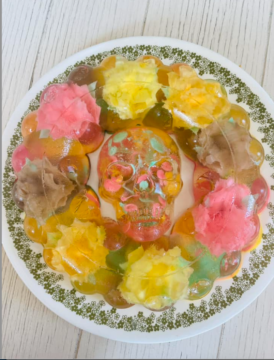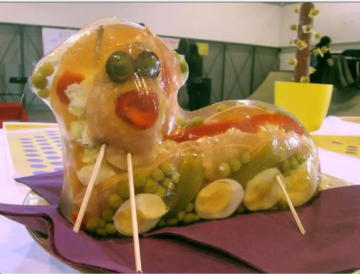by Terese Svoboda
 How plastic – really plastic – gelatin presents as a food. Not only in the “easily molded” sense of a pliable art material but also its transparency. Walnuts and celery, the “nuts and bolts” of gelatin desserts, defy gravity, floating amidst the cheerful jewel-like plastic-looking splendor of the 1950’s, when gelatin was the king of desserts. Gelatin’s mid-century elegance belies its orgiastic sweetness, especially the lime flavor, which is downright otherworldly. If you stir it up hot, half diluted, gelatin lives up to its derelict reputation with regard to the sickbed and sugar, being thick and warm, twice as intoxicatingly sweet, and surely terrible for an invalid’s teeth, if not metabolism. In my novel, Dog on Fire, I hypothesize that lime-flavored gelatin is the perfect murder weapon.
How plastic – really plastic – gelatin presents as a food. Not only in the “easily molded” sense of a pliable art material but also its transparency. Walnuts and celery, the “nuts and bolts” of gelatin desserts, defy gravity, floating amidst the cheerful jewel-like plastic-looking splendor of the 1950’s, when gelatin was the king of desserts. Gelatin’s mid-century elegance belies its orgiastic sweetness, especially the lime flavor, which is downright otherworldly. If you stir it up hot, half diluted, gelatin lives up to its derelict reputation with regard to the sickbed and sugar, being thick and warm, twice as intoxicatingly sweet, and surely terrible for an invalid’s teeth, if not metabolism. In my novel, Dog on Fire, I hypothesize that lime-flavored gelatin is the perfect murder weapon.
I considered many modus operandi, starting with freezing it into the shape of a dagger. However, such a weapon would quickly dissolve into a lime green, mellow yellow or ruby red puddle or, if undyed, at least clear gelid water, and its penetration would definitely leave a hole. Concuss the victim with gallons of gelatin dropped from a height? The abovementioned puddle would give it away, not to mention the victim’s crushed skull. Both methods could be accomplished with more simpler tools. The only totally invisible murder method is past the taste buds: poison-by-gelatin. This has two positive attributes as a murder weapon: it leaves no physical marks and its results can be somewhat timed. Ah, but the autopsy. Surely that would reveal the poison.
Not always.
My friend Rachel Greenfield is writing a book on Rose Knox, the 1920’s maven of gelatin manufacturing. Rachel can discuss the processing of animal bones and hides and concomitant sanitation problems regarding gelatin manufacture and bacterial contamination. Poisoning by gelatin (or “gelatine” as Knox preferred it) was a real hazard in the early days, so Rose sold the public on her sanitary manufacturing process via many pictures of her white kitchen. She also suggested her “gelatine” had none of the poisonous unwholesomeness of its competitor Jello, that is to say, all that sugar – although nearly every recipe Knox ever touted was more than generously sweetened, and diabolical for any diabetes patient. Putting contamination and all that sugar aside, gelatin all by itself provides a blank slate for poison, either savory or sweet.
The Romans and medieval kings were well aware of the link between gelatin and poison. Their four-foot-high sometimes gilded gelatin confections served on the shoulders of eight or so serfs could easily disguise lethal intent, and did. Invited to feasts, political opponents suffered. Gelatin was a much more discrete vehicle for death than a knife in the back, and it was much easier then to get the proper poisons ground and sprinkled in. These days, poisonings tend to be more complicated and synthetic: plastic in the clouds, street drugs, the unidentified mess recycled from the microwave, weed smoked in upscale cafes with “additives.” In Europe, gelatin’s been slapped with warnings and outright bans. It’s genetically modified and contains carcinogenic sweeteners and banned preservatives, not to mention the antibiotics, artificial hormones and GMO feed that’s soaked into the creature’s bones while still kicking. The dyes used in gelatin, in particular Red 40, are made from petroleum and containing benzene, which is a cancer-producing substance, and exacerbate ADHD. But it still has its attractions.
My sister is a professional flavorist working in Chicago, and claims to be the person who made America fat. She designs snacks and drinks. She tells me that texture affects the human’s sense of taste, and that gelatin offers a mysterious chew-swallow mouthfeel of innocence. Scientists can measure how individuals perceive roughness by having subjects lick various grades of metal rasps. Gelatin wins in the least rough category, a big part of its allure. Gullible people will gulp it down.
Serving gelatin used to be a sign that you could afford someone in the kitchen to stir it for hours. After slavery was abolished and the stirring personnel freed, it morphed into a sign of a “modern woman,” with Knox’s speedier recipe, someone with the convenience of a refrigerator stocked with ice could offer its attractions with ease. During WWII, gelatin made women paradigms of frugality, by adding gelatin to butter and other recipe-stretchers. Then, after a postwar decade of prosperity, of bright Melamine bowls and afternoon bridge parties with whipped cream and nuts and bolts, gelatin’s reputation fell and became the poor man’s treat, eaten by someone without choppers or bounced in the wards of the insane. Resurrecting gelatin – picture a sort of Franken-gelatin rising from the mold to re-establish its preeminence – is now the next big thing. Tomorrow food! The purvey of space! Astronaut Peggy Whitson said it was very tempting to play with your food when it floated. Gelatin’s always been a future food, its plastic so moderne, an icon for the new. And it moves! Not quite autonomous, parking itself on your plate, but still, what other food can do the hula?
 A Facebook group called “Aspics with Threatening Auras” boasts some 34,000 followers who post terrifying food sculptures as exemplars of the new gelatin craze. “Silence of the Lambs” is a quivering transparent molded lamb full of vegetables mocking organs.[1] Other offerings include gelled skulls, a halved watermelon filled with a fetal-looking piece of fruit drowned in gelatin aand hooked to a hose, a plethora of gold spikes covered pink mousse-looking delight, “Scenic depictions of Slave Life” presented in a popsickle containing sauerkraut and a red blossom, and a wounded-looking strawberry anus. Joy of Cooking author Irma Rombauer remarked that “Any clever person can take a few desolate-looking ice box leftovers and glorify them into a tempting aspic salad.” But other than food poisoning-by-leftovers, which is always a possibility, what vehicle would the modern day poisoner use with the food of tomorrow? In 1986 an anonymous caller to the New York Times reported he’d laced boxes of Jello with cyanide, although they were never found.[2] Cyanide could be determined in the post mortem – if not earlier, by the gelatin-eater, appalled by the taste of bitter almonds. Something else is required that leaves no trace at all, and then of course, how to get the victim to eat it? I worked on it.
A Facebook group called “Aspics with Threatening Auras” boasts some 34,000 followers who post terrifying food sculptures as exemplars of the new gelatin craze. “Silence of the Lambs” is a quivering transparent molded lamb full of vegetables mocking organs.[1] Other offerings include gelled skulls, a halved watermelon filled with a fetal-looking piece of fruit drowned in gelatin aand hooked to a hose, a plethora of gold spikes covered pink mousse-looking delight, “Scenic depictions of Slave Life” presented in a popsickle containing sauerkraut and a red blossom, and a wounded-looking strawberry anus. Joy of Cooking author Irma Rombauer remarked that “Any clever person can take a few desolate-looking ice box leftovers and glorify them into a tempting aspic salad.” But other than food poisoning-by-leftovers, which is always a possibility, what vehicle would the modern day poisoner use with the food of tomorrow? In 1986 an anonymous caller to the New York Times reported he’d laced boxes of Jello with cyanide, although they were never found.[2] Cyanide could be determined in the post mortem – if not earlier, by the gelatin-eater, appalled by the taste of bitter almonds. Something else is required that leaves no trace at all, and then of course, how to get the victim to eat it? I worked on it.
***
[1] https://burntmyfingers.com/2021/04/16/questionable-recipes-and-threatening-aspics/
[2] New York Times. 9 Oct. 1984. 218.
